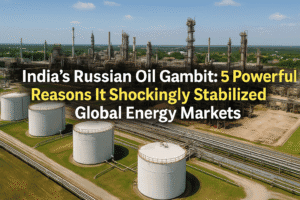India’s Russian Oil Gambit: 5 Powerful Reasons It Shockingly Stabilized Global Energy Markets
India’s sustained purchase of discounted Russian crude, despite Western pressure, acted as a critical shock absorber for global oil markets after the Ukraine invasion. By maintaining imports under the G7 price cap, India prevented the abrupt removal of Russia’s massive 9 million barrel per day output from circulation. This avoided an impossible 10% global consumption cut and averted a catastrophic price surge beyond $120-130 per barrel, sparing consumers worldwide severe economic pain. India’s move, driven by its own need to secure affordable energy for its vast population and economy (importing 80% of its oil), unintentionally stabilized global supply.
Minister Puri rightly highlighted that absorbing this supply under the cap mechanism served global market stability, countering critics who overlooked energy market realities. The episode underscores how pragmatic actions by major consumers like India, even when focused on self-interest, can mitigate wider crises in our deeply interconnected energy system. India’s role demonstrated that navigating such turmoil requires engaging with complex realities, not just political posturing.

India’s Russian Oil Gambit: 5 Powerful Reasons It Shockingly Stabilized Global Energy Markets
While Western sanctions reshaped global energy flows following Russia’s invasion of Ukraine, India’s steadfast import of discounted Russian crude emerged as an unexpected stabilizer, preventing a catastrophic price surge. This pragmatic move, often criticized, arguably shielded the world from far greater economic pain.
The Precarious Balance: Removing 9 Million Barrels
As Petroleum Minister Hardeep Puri underscored in Vienna, the sheer scale of Russian production – exceeding 9 million barrels per day (bpd) – made its abrupt removal from the global market (around 97 million bpd) economically unthinkable. Eliminating roughly 10% of global supply overnight would have demanded an immediate, worldwide consumption cut of equivalent magnitude – a logistical and economic impossibility.
The inevitable consequence? A brutal scramble for scarce barrels. “Imagine the chaos,” Puri stated, painting a picture of consumers worldwide chasing drastically reduced supplies. This intense competition, he argued, would have propelled oil prices far beyond $120-$130 per barrel – a level with devastating inflationary consequences for every nation.
India’s Pragmatic Calculus: Energy Security as Global Stabilizer
Facing the stark reality of importing 80% of its oil and 50% of its gas, India made a hard-nosed decision: continue buying Russian oil under the newly implemented G7 price cap mechanism. This wasn’t defiance, but necessity. By purchasing discounted Russian crude (Urals), India achieved two critical goals:
- Securing Affordable Energy: Protecting its own vast population and rapidly growing economy from crippling energy inflation.
- Absorbing Excess Supply: Acting as a crucial outlet for Russian oil that might otherwise have been completely stranded, effectively taking millions of barrels off the volatile spot market.
Puri framed this not as exploitation, but as a vital contribution: “Sensible decision makers… were aware… how India was only helping the global markets by buying discounted oil under a price cap.” The price cap, while intended to limit Russian revenue, crucially allowed the flow of oil to continue, preventing the worst-case supply shock. India, as the world’s third-largest energy consumer (needing ~5.4 million bpd itself), became a major conduit for this stabilized flow.
Beyond the Criticism: Navigating a Complex Reality
Minister Puri pointedly addressed critics who overlook the fundamental mechanics of energy markets. For a nation of India’s size and import dependency, diversification isn’t a luxury but a survival strategy. While expanding domestic exploration (like in the Andamans) is crucial long-term, immediate needs required engaging with all available suppliers, including Russia offering advantageous terms.
The criticism often misses the profound global consequence: had India and other price-cap-compliant buyers (like China) not stepped in, the void left by retreating Western buyers could have indeed triggered that feared $130+ price spiral. India’s actions, driven by self-interest, inadvertently provided a safety valve for the global economy.
The Uncomfortable Truth of Interdependence
The Ukraine conflict laid bare the deep interconnectedness of global energy. Sanctions designed to pressure Russia risked causing massive collateral damage through energy hyperinflation. The price cap mechanism, while imperfect, acknowledged this interdependence by aiming to keep Russian oil flowing at a discount.
India’s role in this complex dance highlights a crucial lesson: in a globalized energy market, the actions of major consumers, even those acting primarily in their own interest, can have profound stabilizing (or destabilizing) effects worldwide. Pragmatism, in this case, served not only India’s 1.4 billion people but arguably helped anchor a world teetering on the edge of an even deeper energy crisis. The path forward demands continued diversification and investment in alternatives, but the immediate past shows that navigating energy geopolitics often requires choosing the least damaging option in an imperfect world.
You must be logged in to post a comment.